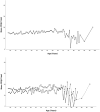Fear of Pain Across the Adult Life Span
- PMID: 33404654
- PMCID: PMC7971466
- DOI: 10.1093/pm/pnaa390
Fear of Pain Across the Adult Life Span
Abstract
Background: Pain continues to be an important public health concern, especially given the opioid crisis in industrialized countries. It is important to understand the association between emotions such as fear and anxiety and the experience of pain as both a physiological and affective experience. Fear or anxiety about pain is in fact a well-known predictor of and close associate of pain. Nociception and pain history differ depending on age, yet little empirical evidence exists on how fear of pain varies over the life span. The purpose of this study was to provide a cross-sectional examination of the relations between age and fear of pain across the adult life span.
Methods: Using cross-sectional data from 4,122 participants who completed the Fear of Pain Questionnaire-9, structural equation modeling and regression techniques were used to examine the association between fear of pain and age.
Results: A positive linear association was discovered between age and fear of severe or minor pain, and a negative association was discovered between age and fear of medical or dental pain. Quadratic and cubic relations were also significant for fear of severe pain, fear of medical and dental pain, and overall fear of pain, but not for fear of minor pain.
Conclusions: Unique trajectories for different components of pain-related fear exist across the adult life span and may be affected by increased exposure to medical and dental experiences over time and by the awareness of a greater likelihood of experiencing pain later in the life span.
Keywords: Age; Development; Health Psychology; Pain; Fear of Pain.
© The Author(s) 2021. Published by Oxford University Press on behalf of the American Academy of Pain Medicine. All rights reserved. For permissions, please e-mail: journals.permissions@oup.com.
Figures




Similar articles
-
Psychometric evaluation of the Japanese version of the fear of pain questionnaire-III and its association with dental anxiety: a cross-sectional study.BMC Oral Health. 2023 Aug 12;23(1):559. doi: 10.1186/s12903-023-03273-8. BMC Oral Health. 2023. PMID: 37573290 Free PMC article.
-
Effects of child characteristics and dental history on dental fear: cross-sectional study.BMC Oral Health. 2018 Mar 7;18(1):33. doi: 10.1186/s12903-018-0496-4. BMC Oral Health. 2018. PMID: 29514657 Free PMC article.
-
The cultural context of anxiety disorders.Psychiatr Clin North Am. 1995 Sep;18(3):503-21. Psychiatr Clin North Am. 1995. PMID: 8545264 Review.
-
Does previous dental care experience make the child less anxious? An evaluation of anxiety and fear of pain.Eur Arch Paediatr Dent. 2021 Apr;22(2):139-143. doi: 10.1007/s40368-020-00527-9. Epub 2020 Apr 29. Eur Arch Paediatr Dent. 2021. PMID: 32346834
-
A meta-analysis of the associations of elements of the fear-avoidance model of chronic pain with negative affect, depression, anxiety, pain-related disability and pain intensity.Eur J Pain. 2022 Sep;26(8):1611-1635. doi: 10.1002/ejp.1994. Epub 2022 Jul 7. Eur J Pain. 2022. PMID: 35727200 Free PMC article. Review.
Cited by
-
Gastrointestinal distress as a potential mediator between stress and periodontal inflammation.Community Dent Oral Epidemiol. 2023 Dec;51(6):1250-1257. doi: 10.1111/cdoe.12889. Epub 2023 Jul 10. Community Dent Oral Epidemiol. 2023. PMID: 37430381 Free PMC article.
-
Fear of Pain as a Predictor for Postoperative Pain Intensity among the Patients Undergoing Thoracoscopic Surgery.Pain Res Manag. 2022 Jun 15;2022:2201501. doi: 10.1155/2022/2201501. eCollection 2022. Pain Res Manag. 2022. PMID: 35757293 Free PMC article.
-
Development and validation of a latent, multidimensional, self-report periodontal disease measure.J Periodontol. 2021 Nov;92(11):1554-1563. doi: 10.1002/JPER.20-0066. Epub 2021 Apr 21. J Periodontol. 2021. PMID: 33651894 Free PMC article.
-
Impact of a 12-week open-label placebo treatment on headache days in episodic and chronic migraine: a study protocol for a parallel-group, multicentre, randomised controlled trial.BMJ Open. 2021 Jun 23;11(6):e045969. doi: 10.1136/bmjopen-2020-045969. BMJ Open. 2021. PMID: 34162645 Free PMC article.
References
-
- Merskey H, Bogduk N, eds.. Part III: Pain terms, a current list with definitions and notes on usage. In: Classification of Chronic Pain. 2nd ed. Seattle: IASP Press; 1994:209–14.
-
- Lautenbacher S, Kunz M, Strate P, Nielsen J, Arendt-Nielsen L.. Age effects on pain thresholds, temporal summation and spatial summation of heat and pressure pain. Pain 2005;115(3):410–8. - PubMed
-
- Zarit SH, Griffiths PC, Berg S.. Pain perceptions of the oldest old: A longitudinal study. Gerontologist 2004;44(4):459–68. - PubMed
-
- Cole LJ, Farrell MJ, Gibson SJ, Egan GF.. Age-related differences in pain sensitivity and regional brain activity evoked by noxious pressure. Neurobiol Aging 2010;31(3):494–503. - PubMed
Publication types
MeSH terms
Grants and funding
LinkOut - more resources
Full Text Sources
Other Literature Sources
Medical

